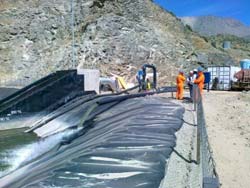Treatment for Wastewater in Open-pit Mines

As the operators can reuse the treated water, the mine requires less water. The wastewater produced by mines is in parts very acidic which contributes to the extraction of metals. The processing plant can treat the most part of the mine's wastewater. A pilot plant for the new treatment technology is installed at a copper mine in Chile.
Everyday, copper mines use tens of thousands of cubic meters of water – some mines even use over one hundred thousand. This corresponds to the water consumption of a medium sized city. Many mines cannot expand their production because they do not have enough water.
Mine operators in Chile are building desalination facilities for sea water and are pumping the valuable water from the coast to the mining regions, which are located at an altitude of 3,000 meters. The wastewater is used to transport fine grain residues to big reservoirs. Increasing water shortages and stringent environmental regulations are forcing mine operators to think about treating and reusing the wastewater.
Siemens is exploiting this trend and is transferring tested processes from the treatment of drinking water to the mines. In the mobile pilot plant, the contaminated water is passed through two treatment stages:
First a micro filters remove particles that are bigger than a thousandth of a millimeter. In the next stage – nanofiltration – the water is passed through a membrane with nanopores so that nearly all pollutants are separated from the water. What is left is pure water of a high quality and a concentrated solution of the contaminants, which must then be disposed of.
The throughput of the pilot plant is nearly 100 cubic meters of water per day – a fraction of the wastewater produced by a mine. Siemens uses the plant to demonstrate the process and to analyze the wastewater produced by a mine, as the composition of each mine's wastewater is different. The data gained by the pilot plant serves as the foundation for the design of the actual treatment facility.
Siemens has been cooperating with the Technical University Bergakademie Freiberg for some years to research innovative concepts for the treatment of wastewater from mines. As the company with the largest environmental portfolio worldwide, which generated sales of approximately €30 billion in fiscal 2011, Siemens can and will make a major contribution in this area.
Media Contact
More Information:
http://www.siemens.com/innovationnewsAll latest news from the category: Ecology, The Environment and Conservation
This complex theme deals primarily with interactions between organisms and the environmental factors that impact them, but to a greater extent between individual inanimate environmental factors.
innovations-report offers informative reports and articles on topics such as climate protection, landscape conservation, ecological systems, wildlife and nature parks and ecosystem efficiency and balance.
Newest articles

A universal framework for spatial biology
SpatialData is a freely accessible tool to unify and integrate data from different omics technologies accounting for spatial information, which can provide holistic insights into health and disease. Biological processes…

How complex biological processes arise
A $20 million grant from the U.S. National Science Foundation (NSF) will support the establishment and operation of the National Synthesis Center for Emergence in the Molecular and Cellular Sciences (NCEMS) at…

Airborne single-photon lidar system achieves high-resolution 3D imaging
Compact, low-power system opens doors for photon-efficient drone and satellite-based environmental monitoring and mapping. Researchers have developed a compact and lightweight single-photon airborne lidar system that can acquire high-resolution 3D…





















